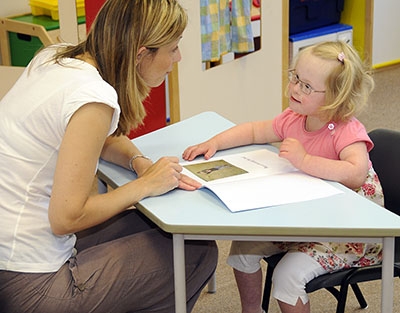"How to Conduct Special Education Sessions."
**Special Education Sessions: How to Conduct Them**In the field of special education, the rehabilitation of children is achieved through training sessions. These training sessions are divided into two types: individual sessions and group sessions.
### Individual Sessions:
Each child with special needs has a specific approach or entry point that can be used during training. This entry point varies from child to child, depending on the type and degree of disability and their ability to pay attention and concentrate. As a result of these differences, special education specialists use the method of “individual sessions.”
Individual sessions refer to tailoring the educational approach according to the personality and abilities of the child of interest. The importance of individual sessions lies in:
- Complete focus on the child and providing them with attention.
- The ability to meet the specific individual needs of the child.
Individual sessions have criteria and conditions that must be adhered to in order to achieve the best possible benefit, such as:
- The session should be conducted in a quiet place away from noise.
- The lighting should be sufficient (preferably not behind the child to avoid distracting shadows).
- The specialist should prepare the educational tools in advance to avoid wasting time during the session.
- The appropriate duration for the session is about 30 minutes on average (some children may not be able to tolerate this duration due to attention deficits, while others can endure longer).
- It is advisable to vary the objectives and activities within the session (motor, cognitive, language goals, etc.).
- The specialist should possess certain qualities during teaching and training, such as patience, cheerfulness, high ability to focus and pay attention to the child's performance, and the ability to anticipate.
- It is important to record the child's performance at the end of the activity or session to keep the specialist informed of what occurred during the session.
### Group Sessions:
Group sessions involve training more than one child at the same time. This type of session is used to serve specific rehabilitation objectives that require such an approach. Some of these objectives include:
- Training children on behavioral and social goals: the social aspect requires a small community for the child to practice desired behaviors.
- Practicing and generalizing performance: the child learns behaviors in individual sessions and needs to practice these behaviors to generalize and incorporate them into their daily life. Group sessions provide this opportunity.
- Educational approach: Children are more active and engaged when training is conducted among peers, where competition and enjoyment are present.
As a result, group sessions are considered an effective training method used in special education. These sessions have criteria and conditions that, when followed, can achieve desired results. Some of these conditions include:
- The session should be held in a quiet place free from distractions.
- The appropriate number of children is 4-5, along with a special education specialist and an assistant.
- There should be adequate preparation for the session in terms of tools and activities.
### Objectives:
In group sessions, there are multiple children and, consequently, multiple training programs. Therefore, it is necessary to align the goals of different training programs by selecting closely related objectives. These objectives should ideally be skills that the child has already begun training on in individual sessions, which they need to generalize and practice in group sessions. It is also important to vary the objectives so that they are not all in one field to prevent boredom and maintain motivation among the children. Additionally, the number of objectives should not be too large for any one session, and they should be interrelated to enhance focus.
Regarding activities: the more visually appealing the activities and tools, the better. They should be simple in their steps and execution. Activities inspired by the child’s environment are preferable as they can be practiced continuously, whether at home or in rehabilitation settings. For example:
(Activity: “Brushing teeth with a toothbrush and toothpaste.” This activity includes cognitive goals like identifying used tools and directions for brushing teeth, as well as self-care goals like personal hygiene and fine motor skills like holding the toothbrush and squeezing the toothpaste, and gross motor skills like moving the arm.)
This activity can be designed attractively for children using bright-colored tools, and it is also related to the child's environment.
However, after understanding the above, an important question arises: “How can this activity be implemented in a group session?”
This activity can be carried out by following these logical steps:
1. Identify the children to be trained.
2. Define the objectives to be achieved based on the number of children and the interrelation of the objectives.
3. Design or determine suitable activities to achieve the objectives, along with specifying their required tools and the appropriate setting.
4. Determine the seating arrangement for the children and assistants, allowing for necessary movement freedom during the activity, maintaining order, preventing distractions, and ensuring the safety of the children.
5. Implementation: At the beginning of the activity, introduce the children and prepare for the activity, then proceed with the steps of the activity. At the end of the session, summarize the activity and conclude by thanking the children and providing encouragement (morally or materially) according to their levels.
6. Record children’s responses in a follow-up or activity notebook for future reference.
In conclusion, group activities are an important and effective means in the training and rehabilitation process for children. Generally, training sessions, in all their forms, are essential in the training process, with each form having its appropriate time and place.
**Article prepared by:**
A/ Heba Ibrahim
Special Education Specialist at Kayaan Association









Comments (0)